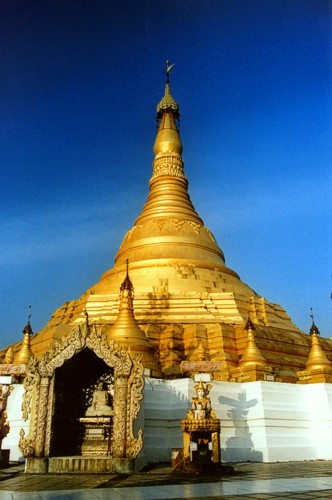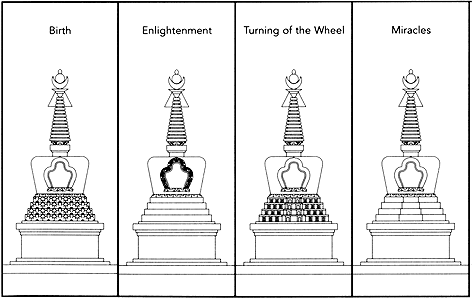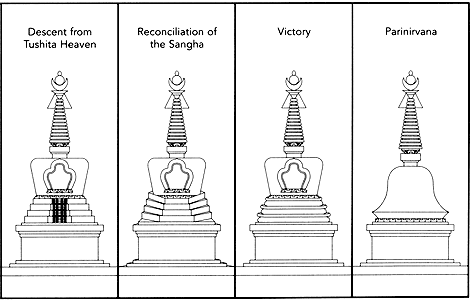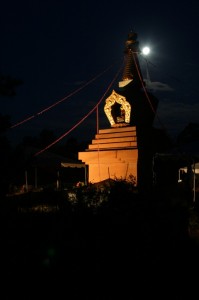An excerpt from the teaching “Cosmology of a Stupa” given by Tulku Sang-ngag Rinpoche
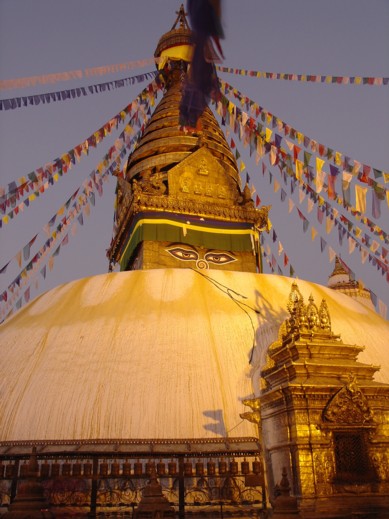
You might wonder, “Is this tradition of erecting stupas something that stems from the historical Buddha Shakyamuni?” If you really investigate it, you will find that actually, there were stupas that appeared prior to Buddha Shakyamuni. During the time of the third Buddha, Dipankara, there were numerous stupas erected.
There is a long history of stupa making in this world. For example, there is a very famous stupa in the Kathmandu Valley at Svayambhu. Svayambhu means the “Spontaneously Self-Arisen” stupa. During the time of the second Buddha, Marme-dze, that stupa was said to have dwelled in the sky on the top of the mountain. It was floating in space. And then during the time of the third Buddha, Dipankara, the stupa went below ground. And then during the fourth Buddha, Shakyamuni, the most recent Buddha, this stupa emerged so that half of it was out of the ground and half of it was still in the ground.
This stupa in Svayambhu is truly a miraculous stupa. It is famed as being an amazing stupa. In the sixth Nepalese month, which would be the fourth western month, there is a great celebration on the full moon. After that, you can actually see a reflection of the stupa in the sky. Whether you are Buddhist or non-Buddhist, everyone can witness the appearance of this stupa in the sky.
Stupas were also created during the lifetime of Shakyamuni Buddha. In fact, the very text for consecrating stupas came from words spoken directly by the Buddha. It is known as the “Sutra of the Twofold Purity.” Of the various teachings that that Buddha gave, some of them came directly out of his topknot. Others emanated. And some were spoken orally. This is one of those teachings that was an oral transmission, and is considered to be a very sacred practice for consecrating land.
This teaching on how to consecrate land is called the “Twofold Purity Practice” because one of the two recipients of the teaching was a child of the gods known as Vimala Ratna, and the other was a human known as Sakya Chandra.
Here is the background of this Brahmin, Sakya Chandra. Initially he was a great practitioner of the Tirtika tradition who held a bit of animosity towards the Buddhists. One day this Brahmin received a prediction from a deity saying that in seven days his life would come to an end. This really perturbed him and he set about looking for some way to protect himself from that fate – some kind of method or practice. But he couldn’t find any.
He started to run out of options. His search led him to consider going to the Buddha. He reflected on that. He wondered if he should do that or not, because prior to that time, he had been so antagonistic towards the Buddha. He had been an enemy of the Buddhist teachings. He was at a crossroads, wondering what to do. But then he thought, “Well, Buddhists are compassionate and maybe they will take pity on me, and I can get some advice on how to get out of this predicament.”
He decided that he would go to see the Buddha, and so he went off to the Jetavana Grove where the Buddha was teaching a group of people. When he got close, he saw that there were lots of people attending the teaching. He felt very self-conscious. He was thinking, “Gosh, I was an archenemy of the Buddha’s teachings. Now I am walking right into the center of this enormous audience of people while the teaching is going on. I can’t do that.” He lost his courage and scurried off behind a wall and started crying about his fate. The Buddha finished teaching, and said, “Over there is a wall and behind that wall there is a person who is very upset. Bring him to me.”
The Buddha said to this fellow, “You have something to tell me. What is it? The clock is ticking.” And this guy says, “Well, in seven days I am predicted to pass away. Is this actually true that I am going to pass away in seven days? Is there anything that I can do?”
The Buddha said, “Yes, in fact, it is true. But it gets worse. After you pass away, you are going to take on numerous bad rebirths and finally, you are going to plummet into the lowest hell realm.”
Sakya Chandra was already freaked out about dying, and now in addition, he had to worry about all those negative rebirths. He was so completely overwhelmed that he passed out.
Finally when Sakya Chandra revived, the Buddha said, “Actually, there is something that you can do about this situation. There is a method that you can employ to counteract this whole thing. You don’t have to actually experience this. You just need to employ this method.”
The Brahmin was so elated to hear this news, that there was something that he could actually do to counteract his circumstance. The Buddha then said to him, “Near here there is a stupa from a previous Buddha. This stupa is dilapidated and run down. What you should do is restore that stupa.” And so the Buddha gave him instructions on how to do that, how to draw the mandalas, what scriptures to write, how to put in the life wood, which is the axial wood that goes into the center of the stupa, how to insert it, and what to write and carve on it.
Then the Buddha declared that not only would his life span be restored, but also he would close the door to the lower realms and eventually reach the higher realms of Akanishta Pure Land, the highest Pure Land, where he would achieve incredible qualities of enlightenment. The Brahmin, Sakya Chandra, went straight away and started to repair the stupa. He didn’t even go home. He went straight there and started the work.
Along with that teaching, the Buddha gave another called the Complete Elucidation on How to Accomplish Everything, as well as the Wheel that Fulfills All of One’s Wishes or Desires. There is a long ceremony and mantra associated with that,. It is a practice that one can perform in order to do that. The Buddha declared that the erecting of a stupa had numerous qualities. It was an efficacious means whereby one could accumulate a massive store of merit and wisdom.
The Buddha said that the individual who erects a stupa is blessed by all the Buddhas and the bodhisattvas. That person receives the blessings of the enlightened ones. If one creates a stupa that is a reliquary for ringsel (Ringsel are indestructible sacred relic pills that appear from the ashes of enlightened beings), then all the bodhisattvas bless that person. One will have the good fortune of seeing the face of the enlightened ones. One will be an object of homage of all the gods, such as Brahma and Vishnu and Indra. All these enlightened beings – the Buddhas and the bodhisattvas – and also the mundane gods will commit themselves to protecting you because you have really enhanced the benefit of those who are on the path to enlightenment.
The image of the Swayambhunath Stupa above came from the Rigpa Shedra Wiki
